The Safety Reporting Systems Market is estimated to be valued at USD 4.3 billion in 2025 and is projected to reach USD 15.4 billion by 2035, registering a compound annual growth rate (CAGR) of 13.5% over the forecast period.
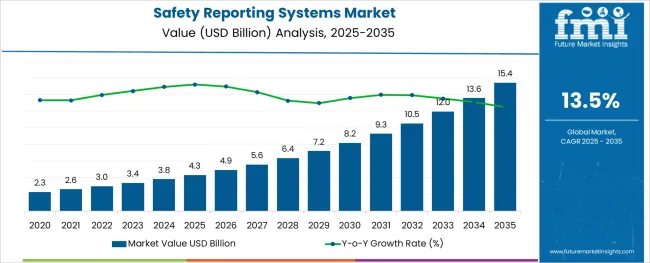
The safety reporting systems market is witnessing accelerated growth as organizations increasingly prioritize proactive risk identification, regulatory adherence, and data-driven safety culture. Regulatory frameworks across industries such as healthcare, aviation, and manufacturing are mandating transparent and timely reporting of safety incidents, fueling demand for integrated digital platforms.
Organizations are shifting from manual reporting tools to intelligent systems equipped with real-time dashboards, mobile access, automated alerts, and analytics capabilities. The adoption of cloud infrastructure, AI-powered insights, and multi-device accessibility has expanded the functionality of modern safety reporting platforms.
Moreover, increased scrutiny on workplace safety, especially post-pandemic, has encouraged enterprises to implement scalable systems that support root-cause analysis and continuous improvement workflows. As safety accountability becomes integral to ESG goals and corporate governance, the market is expected to benefit from rising investments in digital safety ecosystems that support both compliance and operational excellence.
The market is segmented by Delivery Mode, Solution Type, End-User Industries, and Enterprise Type and region. By Delivery Mode, the market is divided into Cloud-based and On-premise. In terms of Solution Type, the market is classified into Software and Services. Based on End-User Industries, the market is segmented into Healthcare, Manufacturing, Construction, Energy Utility, Hospitality, and Others.
By Enterprise Type, the market is divided into Large Enterprise and Small and Medium Enterprise. Regionally, the market is classified into North America, Latin America, Western Europe, Eastern Europe, Balkan & Baltic Countries, Russia & Belarus, Central Asia, East Asia, South Asia & Pacific, and the Middle East & Africa.
The market is segmented by Delivery Mode, Solution Type, End-User Industries, and Enterprise Type and region. By Delivery Mode, the market is divided into Cloud-based and On-premise. In terms of Solution Type, the market is classified into Software and Services. Based on End-User Industries, the market is segmented into Healthcare, Manufacturing, Construction, Energy Utility, Hospitality, and Others.
By Enterprise Type, the market is divided into Large Enterprise and Small and Medium Enterprise. Regionally, the market is classified into North America, Latin America, Western Europe, Eastern Europe, Balkan & Baltic Countries, Russia & Belarus, Central Asia, East Asia, South Asia & Pacific, and the Middle East & Africa.
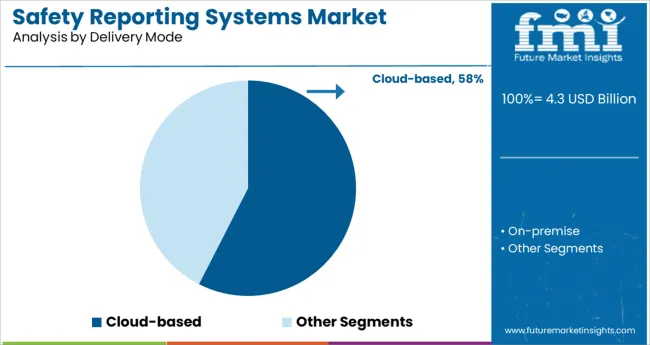
The cloud-based segment is expected to lead the delivery mode category with a projected 57.5% revenue share in 2025. This leadership is attributed to the increasing preference for scalable, secure, and cost-effective deployment models that eliminate infrastructure overhead and enable seamless upgrades.
Cloud-based systems offer superior accessibility across locations and devices, which is essential for organizations with distributed teams or multi-site operations. Enhanced data recovery, security features, and real-time collaboration capabilities have further reinforced trust in cloud-based safety reporting tools.
Additionally, cloud architecture supports API integrations with third-party tools like HR systems, compliance trackers, and analytics engines, improving overall operational agility. The flexibility to scale up quickly in response to evolving regulatory needs or enterprise growth has cemented the dominance of cloud delivery models in the safety reporting landscape.
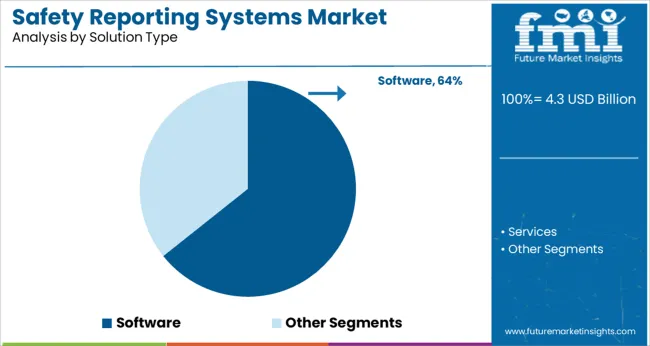
Software-based safety reporting solutions are projected to hold a commanding 64.3% revenue share in 2025 within the solution type category. This leading position stems from the software’s ability to deliver comprehensive incident capture, workflow automation, escalation management, and compliance tracking through intuitive dashboards.
The growing complexity of safety regulations and the need for real-time reporting accuracy have prompted industries to adopt software that supports audit readiness and advanced analytics. Many solutions now incorporate machine learning to identify reporting trends and potential risk areas, enhancing their strategic role in safety operations.
The shift from reactive paper-based processes to integrated software ecosystems has also streamlined communication between frontline staff, safety officers, and compliance teams. This has driven sustained adoption across sectors aiming to centralize safety data, standardize procedures, and improve transparency.
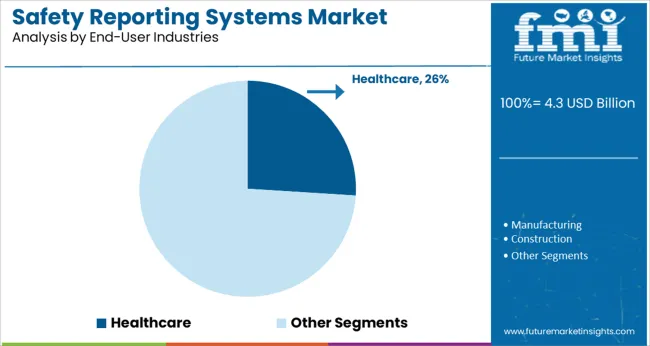
The healthcare segment is expected to account for 26.0% of total revenue by 2025, making it the leading end-user industry in the safety reporting systems market. This dominance is driven by regulatory mandates to document, investigate, and resolve patient safety events, medication errors, and procedural complications.
Healthcare providers are increasingly relying on structured digital systems to capture adverse event data in real time and ensure compliance with health authority standards. The growing emphasis on patient outcomes, risk mitigation, and incident trend analysis has led to widespread integration of safety reporting software into hospital information systems and clinical workflows.
Moreover, the need for confidential, easy-to-use platforms that can be accessed across departments has reinforced adoption. With safety metrics directly tied to quality ratings, reimbursements, and public trust, healthcare institutions are prioritizing investments in modern safety systems that offer traceability, accountability, and continuous improvement capabilities.
Recent years have seen the safety reporting systems industry grow at an optimal rate, and this trend is expected to continue. Accordingly, safety reporting systems' market size has increased due to rising investments in research and development, entry of competing players, product innovation, technological breakthroughs, efficient resource allocation, and growing competition among competitors to expand their regional and customer bases.
Supportive government policies and incentives, as well as favorable laws, are projected to drive the growth of the safety reporting systems market in the foreseeable future. An increase in the spending capacity of customers with the rise in disposable income will further contribute to Safety reporting systems' market proceeds.
There are several major factors driving the market for safety reporting systems. These factors include government safety regulations, multiple statutory and legal requirements, and enterprise investments in these systems to improve customer experience and employee experience.
Additionally, factors such as the use of automation and interconnectivity over manual processes and the shift in the delivery of medical care for patient-centric healthcare regulations are propelling the safety reporting systems market to grow.
The high initial investment and complex solutions required to comply with a few legal and government regulations are restricting the growth of the market for safety reporting systems. Also, regulatory compliances with hospital incident-reporting systems hinder the safety reporting systems market.
A few of the opportunities for the safety reporting systems market include the increasing demand for Safety reporting systems in the aviation and healthcare industries, as well as technological advancements in software and systems used to report on quality and safety.
The high initial investment and complex solutions required to comply with a few legal and government regulations demand huge working capital, which only favors key players. Start-ups and SMEs with low investment potential feel the brunt of high overheads and have a chance to progress if they get into mergers, acquisitions, or contracts.
To top it up, regulatory compliances regarding the safety reporting systems are also likely to challenge the players in the safety reporting systems market, thereby making it difficult to contend with.
On the other hand, the market holds opportunities for the safety reporting systems market to cash in on. Increasing demand for safety reporting systems in the aviation and healthcare industries is likely to bring in an additional revenue pocket for the market players. In addition to this, technological advancements in software and systems used to report on quality and safety are also likely to improve the adoption rate during the forecast period.
All-in-all, consistency in terms of innovation and adoption of technology could save manufacturers from making it a deal lost in the market, which otherwise holds abundant opportunities.
North America and the European region are having the highest markets and are expected to dominate the Safety reporting systems market in the future, due to the presence of big healthcare and manufacturing enterprises in these regions.
The North American safety reporting systems market is expected to grow at a substantial rate due to the increasing use of automation and safety systems. In terms of consumption, North America is expected to be followed by Europe as quality and safety reporting requirements expand in manufacturing and energy, and utility industries.
Asia Pacific's safety reporting systems market is identified as the fastest growing market owing to the growth of huge investments and outsourcing of pharmaceutical organizations in this region. Also, increasing the Safety reporting systems application for healthcare safety and error reduction and prevention process in the Asia Pacific region.
Latin America and the Middle East region are also catching up with the Safety reporting systems market at a considerable pace and are expected to grow in the near future due to an increase in awareness of safety and quality standards.
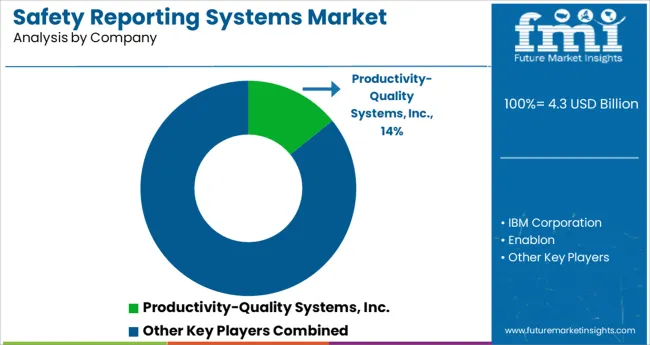
Productivity-Quality Systems Inc., IBM Corporation, Enablon, Alcumus Group Ltd, Gensuite LLC., Abbott Laboratories, SAP SE, Intelex Technologies, Datix Limited, Wolters Kluwer N.V., The Patient Safety Company, Riskonnect, Inc., and PowerHealth Solutions are some of the key players in the Safety reporting systems market.
Emerging trends in the safety reporting systems market, in addition to new product launches in their catalogs, strategic players in the safety reporting systems market cater to the demand by investing heavily in new product launches across the globe.
| Report Attribute | Details |
|---|---|
| Growth Rate | CAGR of 13.5% from 2025 to 2035 |
| Base Year for Estimation | 2025 |
| Historical Data | 2020 to 2024 |
| Forecast Period | 2025 to 2035 |
| Quantitative Units | Revenue in USD Million and CAGR from 2025 to 2035 |
| Report Coverage | Revenue Forecast, Volume Forecast, Company Ranking, Competitive Landscape, Growth Factors, Trends, and Pricing Analysis |
| Segments Covered | Delivery Mode, Solution Type, End-User Industries, Enterprise Type, Region Forecast till 2035 |
| Region Covered | North America; Europe; Asia-Pacific excluding Japan; Latin America; Middle East and Africa |
| Key Companies Profiled | Productivity-Quality Systems Inc.; IBM Corporation; Enablon; Alcumus Group Ltd; Gensuite LLC.; Abbott Laboratories; SAP SE; Intelex Technologies; Datix Limited; Wolters Kluwer N.V.; The Patient Safety Company; Riskonnect, Inc.; PowerHealth Solutions; Others |
| Customization | Available Upon Request |
The global safety reporting systems market is estimated to be valued at USD 4.3 billion in 2025.
It is projected to reach USD 15.4 billion by 2035.
The market is expected to grow at a 13.5% CAGR between 2025 and 2035.
The key product types are cloud-based and on-premise.
software segment is expected to dominate with a 64.3% industry share in 2025.






Full Research Suite comprises of:
Market outlook & trends analysis
Interviews & case studies
Strategic recommendations
Vendor profiles & capabilities analysis
5-year forecasts
8 regions and 60+ country-level data splits
Market segment data splits
12 months of continuous data updates
DELIVERED AS:
PDF EXCEL ONLINE
Safety Label Market Size and Share Forecast Outlook 2025 to 2035
Safety Bottle Tote Carriers Packaging Market Size and Share Forecast Outlook 2025 to 2035
Safety Towing System Market Size and Share Forecast Outlook 2025 to 2035
Safety Syringe Market Size and Share Forecast Outlook 2025 to 2035
Safety Actuators Market Size and Share Forecast Outlook 2025 to 2035
Safety Needles Market Size and Share Forecast Outlook 2025 to 2035
Safety Laser Scanner Market Size and Share Forecast Outlook 2025 to 2035
Safety Limit Switches Market Size and Share Forecast Outlook 2025 to 2035
Safety Eyewear Market Analysis - Size, Share, and Forecast 2025 to 2035
Safety Box for Syringe Market Size, Share & Forecast 2025 to 2035
Safety Valve Market Size, Growth, and Forecast 2025 to 2035
Safety Relays Market Size, Share, and Forecast 2025 to 2035
Safety Mirrors Market - Growth & Forecast 2025 to 2035
Safety Switches Market Trends – Growth & Forecast 2025 to 2035
Safety Interlock Switches Market Analysis by Actuation Method, Application and End-use Industry and Region 2025 to 2035
Safety Light Curtains Market Growth - Trends & Forecast 2025 to 2035
Key Companies & Market Share in the Safety Eyewear Sector
Industry Share Analysis for Safety Box for Syringe Companies
Safety and Process Filter Market Growth – Trends & Forecast 2024-2034
Safety And Eyewash Shower Market

Thank you!
You will receive an email from our Business Development Manager. Please be sure to check your SPAM/JUNK folder too.
Chat With
MaRIA